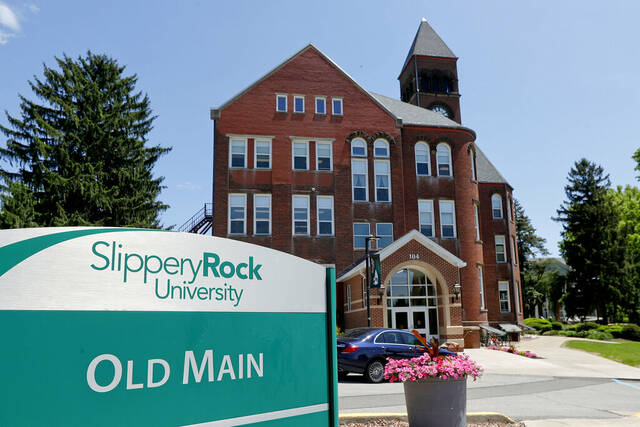https://triblive.com/news/pennsylvania/pa-state-universities-turn-focus-to-drawing-in-more-students-driving-out-more-graduates/
Pa. state universities turn focus to drawing in more students, driving out more graduates

Pennsylvania’s state university system looks a lot different today than it did just five years ago when it began the process of redesigning itself to address the challenges that tested the survival of some of its universities.
Initially, a good bit of its focus rested on trying to keep all of its campuses financially afloat. On Thursday, the State System of Higher Education officials announced at its quarterly board meeting it is now ready to move to the next phase of its ongoing transformation.
In this new phase attention turns to enrolling more students into its universities for degree and non-degree credentials and turning out graduates to meet the state’s workforce needs to make Pennsylvania economically competitive.
“We are well prepared to move in this direction,” system Chancellor Dan Greenstein told the board.
The priorities identified in this new phase includes improving student retention and graduation rates and attracting students who may be ready for college but are not enrolling or those who have incomplete degrees or working adults looking for an industry credential to advance their career.
Additionally, the objectives it has set forth for the next three years seek to keep the cost of attendance within reach for more students, continue to have its universities live within their financial means, grow the system’s partnership with the state, and invest in its faculty and staff to meet student needs.
“The future of the system really depends on our ability to transform ourselves,” said Cynthia Shapira, who was re-elected as the system’s board chairwoman at the meeting. “We have to do our part by doubling down on our efforts to get students in and out and into successful careers or into advanced programs. That’s our job.”
As of the start of this month, the system’s redesign efforts saw its size shrink by four universities through the consolidation of six of its universities into two institutions. Those consolidations remain a work in progress although they are admitting their first cohort of students this fall.
The system also is on course to have all of its universities achieve and maintain financial stability. Numerous governance and leadership changes have been made and the system’s accountability strengthened. And four years ago, it demonstrated a commitment to making student affordability a higher priority by holding the line on tuition at $7,716 for in-state undergraduates for two semesters while urging the state to invest in more direct aid to students.
All of that grows out of the legislature’s demands for more accountability, accessibility and affordability from the system of state-owned universities.
By responding to those demands, system board vice chairman Sam Smith, a former state House speaker, said it helped rebuild lawmakers’ trust in the system leadership as evidenced by the $75 million — or 16% — boost in base funding for the system to $552.5 million in the recently enacted 2022-23 state budget.
Additionally, the system received as part of the budget package a one-time $125 million investment from federal American Rescue Plan dollars to assist with its redesign efforts that builds on a $50 million one-time investment from that same pool of money last year.
“We demonstrated accountability for the dollars they have given us and that wasn’t the case for many years,” Smith said. “This system was in pretty bad shape.”
Prior to the redesign, he said the system faced the possibility of having to close one or two under-enrolled universities or arguably bankrupting the whole system from universities subsidizing their financially imperiled sister schools.
But system leaders say through the myriad of transformational measures it has undertaken on an aggressive timetable — one that continues to give faculty heartburn — it is ready to advance to its next phase and Greenstein is excited to about it.
“We’re really at a watershed moment where we have an opportunity, the opportunity that so many of us have fought so hard for and worked so hard for to accomplish and it’s here,” the chancellor said.
Faculty union President Ken Mash said some of his faculty colleagues also are excited to begin the work associated with the objectives in this new phase. At the same time, it’s hard on them when they know hanging out there are 27 of their former colleagues furloughed in 2020 waiting to be called back and others who have been told to expect to their positions to go away at the end of the 2023-24 academic year.
That has a demoralizing effect across the faculty ranks as well as a lasting one, Mash said.
“Recruiting faculty becomes more difficult because the institution has now a reputation for turning their backs on that trust that people expect,” Mash said to the board in pleading with them to work to find positions for those who have been or will be displaced.
Greenstein said afterward he recognizes the importance of faculty and the impact those job actions have had on them. But he said they were necessary in light of the situation the system faced and is working to address through its redesign efforts.
“The redesign is to stabilize the system financially to rebuild our confidence with the state to generate the investment we need to invest in our people. It’s really simple,” Greenstein said. “The rate of the pace of change has been tremendous but … it’s good now that our owners believe in us. It’s a promising start.”
As for enrollment, Greenstein said it’s still early but some of the system universities could see their enrollments return or possibly surpass their pre-pandemic levels. Last year, the system saw the biggest decline in well over two decades, dropping to 88,651 students.
The system universities include Cheyney, East Stroudsburg, Indiana, Kutztown, Millersville, Shippensburg, Slippery Rock and West Chester as well as Pennsylvania Western University’s California, Clarion and Edinboro campuses, and Commonwealth University’s Bloomsburg, Lock Haven and Mansfield campuses.
Copyright ©2025— Trib Total Media, LLC (TribLIVE.com)
